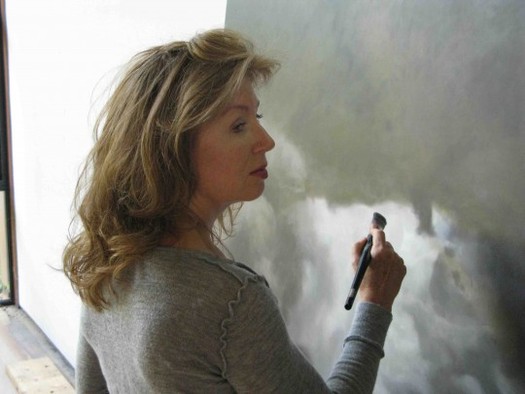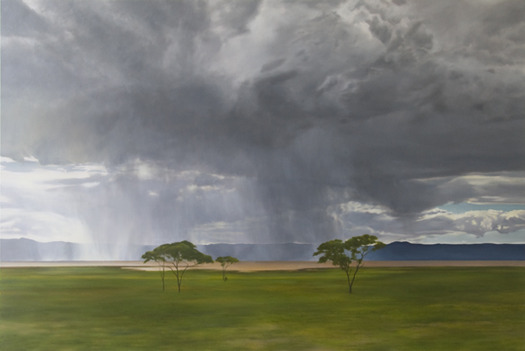
April Gornik (Photo: Eric Fischl)
Editor's Note: This is the third in a six-part series from Adam Harrison Levy about designers, artists and cooking. To see all the installments, click here.
A hotplate, boredom and a book ignited April Gornik’s impulse to cook. She was 23 and a student at the Nova Scotia School of art and design. The winters were long and the evenings felt endless. “Someone got into making these fancy meals. So I joined in the spirit of the game. I got hold of Julia Child's Mastering the Art of French Cooking and instantly I was incredibly ambitious.”
At the time, she was dating the painter Eric Fischl who was teaching at the school, and whom she later married. It was amongst the faculty that this “weird cooking competition” took off. For Eric's 29th birthday, she made sole bonne femme, scalloped potatoes and a gateau of crêpes layered with a frangipane and apple filling, flambéed with rum. All were made on a hot plate and an electric skillet because they had no stove.
Cooking was not an essential part of Gornik's childhood in Mayfield Heights, a town just outside of Cleveland, where she grew up. “My mother was a good cook within a sort of suburban range. She was good at spicing things. But she didn't let me into the kitchen. It was a domain thing.” When Gornik was a child, her favorite food was spaghetti. “Now,” she says with self-deprecating humor, “as an adult with considerable mileage, my favorite food is still spaghetti, although I usually call it pasta.” Her other favorite adult food is artichoke. Her recipe of choice is a simple yet sophisticated blending of the two.
For her, food is all about comfort. When she was a child, and was recovering from an illness, her mother always made her eggs. There is an echo of the restorative sense of well being in her eating habits today. “I really look forward to breakfast and I usually have an egg or two. These are always organic with no antibiotics. Breakfast is my favorite meal of the day. It's like Groundhog Day. Each day is like I never had it before.”
What's quirky about her breakfast is that she eats it between 12:00 and 2:00 in the afternoon. She has fruit first thing in the morning, usually exercises, and then takes care of emails. She then has her “breakfast” when most people have their lunch. She paints from about three to seven. “It's a biorhythm thing,” she says.
But when Gornik says she has “an egg or two” for breakfast, it doesn't do justice to her particularity and her attention to detail. She gets into what she calls a repetitive “eating groove” that can last for a year or even two. Her breakfast groove at the moment is for scrambled eggs, in which she uses fresh basil and chives cooked with olive oil but with just a specific touch of butter — an eighth of a teaspoon. She accompanies this with a large slice of toast. She laughs, almost giggles. “The bread is whole wheat multi-grain, of course.”

Lake Light, April Gornik, 2008, Oil on linen, 72" x 108"
She believes that some artists make extremely gifted chefs. Cooking and creating art draw on similar skills. “Once artists get interested in cooking they can execute brilliantly.” Their highly attuned aesthetic sense translates into the preparation of food. They draw upon qualities that are not dissimilar to those needed in art: “balance, variety and simplicity.”
When it comes to painting, Gornik has an extremely nuanced view of her own work. Her landscapes draw upon a rich and varied tradition of painting ranging from the American artists Martin Johnson Heade and Albert Ryder to Europeans such as Matisse, Monet and Giotto, as well as Japanese wood blocks and Angkor sculpture.
While painting she strives to bring intention to every brushstroke. Like the eighth of a teaspoon of butter in her breakfast eggs, her attention to the ingredients of painting is intense: “There is a sense of detail I've found necessary in order to invoke kinds of turbulence (like the surface of water), or complexity (like how humidity hangs in air), or the weight of an element in a painting (which could be the depth of space or how a flat plain feels).” She works hard to make sure she never paints boringly, “because otherwise that gets embedded in the painting. I have to stay awake and mindful.”
Her approach to food is similar. It's the details that matter; they bring an unexpected nuance or zing to a dish. Discussing tomato soup, one of the most basic of foods, she asks, “have you ever tried adding a little cinnamon?” In her cooking, as in her art, nothing is taken for granted.
April's Pasta Recipe
Dreamlands pasta is my favorite, if you can find it, or Barilla.
For 2 people:
P { margin-bottom: 0.08in; }
Peel, de-choke, and slice thinly 2 big or several smaller artichokes*.
Thinly slice and then sauté several cloves of garlic, depending on size and garlic tolerance/affection, in extra virgin olive oil, on medium (not high) heat for a couple of minutes.
Throw in the sliced artichokes and cook till tender, or, if your artichokes were a little tough to begin with, add about 1/4 cup of water and let them simmer for a few minutes to hasten the cooking process. You want them cooked but not soggy.
If you already have some lovely organic tomato sauce on hand — I make mine by stewing whole, chopped tomatoes with similarly sliced sautéed garlic, a few big fresh bay leaves, a pinch of sugar, salt & pepper — you can add it to the artichokes to warm it or finalize their cooking. If you don't have your own nice plain marinara sauce, use something very simple, or even just add fresh chopped tomatoes (be sure to add a little more garlic at the beginning if you're using fresh) and again, you can use them to finalize the cooking of the artichokes.
Get your pasta going in the meantime. I like thin spaghetti for this recipe. Bring your water to the boil without oil or salt, because the oil isn't necessary (I used to think it was) and the salt can be added after it boils, because apparently it takes longer for water to boil if it's salted. Cook it al dente.
Either you'll have a pesto made before you begin, or you can whip one up. I use a Sicilian style pesto for this recipe, which is garlic, pine nuts, fresh basil, fresh mint, rinsed capers and extra-virgin olive oil. Use preserved capers in sea salt if you can find them, not the vinegary kind; Gustiamo.com is a good source. Add a nice teaspoon per person at the very end so it stays zingy, toss your just-cooked still-hot pasta in and serve immediately.
The other variation you can use, also Sicilian-inspired, would be to use lemon zest (about 1/2 lemon), pine nuts, a few capers, some golden raisins or currants, fresh tomatoes or tomato sauce, and fresh mint. This is equally fun and a nice variation on artichoke pasta, and no need to have it be pesto, just chop it up a bit and let the flavors duke it out in your happy mouth.
* To do this, snap off the outer leaves of the artichokes until they're snapping at their bases. At that point you've reached their tender interior. Cut off the top of the artichoke just above the whitish area, and then cut off the stem just below the base. Turn the artichoke upside down on its cut top, and with a small paring knife peel off any tough remaining outer leaf areas and the outside of the stem. Quarter it lengthwise. Run your knife along the base of the furry choke part, and zip it out of there. Cut the tender remaining artichoke into thin lengthwise slices. It's also lovely to just simply sauté these slices with garlic, fresh mint, and sea salt and serve. This seems like a pain in the butt to execute, but after you've done it a few times it's a breeze.
A version of this article was originally published on Gourmet Live!

